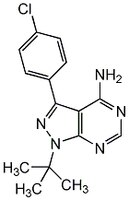529576 Sigma-AldrichInSolution™ PP2 - Calbiochem
InSolution™ PP2, 172889-27-9, is a 10 mM solution of PP2 (Cat. No. 529573) in DMSO. A potent, reversible, ATP-competitive, inhibitor of the Src family of protein tyrosine kinases.
More>> InSolution™ PP2, 172889-27-9, is a 10 mM solution of PP2 (Cat. No. 529573) in DMSO. A potent, reversible, ATP-competitive, inhibitor of the Src family of protein tyrosine kinases. Less<<Produits recommandés
Aperçu
| Replacement Information |
|---|
Tableau de caractéristiques principal
| Empirical Formula |
|---|
| C₁₅H₁₆ClN₅ |
Prix & Disponibilité
| Référence | Disponibilité | Conditionnement | Qté | Prix | Quantité | |
|---|---|---|---|---|---|---|
| 529576-1MG |
|
Ampoule plast. | 1 mg |
|
— |
| Description | |
|---|---|
| Catalogue Number | 529576 |
| Brand Family | Calbiochem® |
| References | |
|---|---|
| References | Hanke, J.H., et al. 1996. J. Biol. Chem. 271, 695. Selected Citations Lee, J., et al. 2009. Cell Stem Cell 5, 76. |
| Product Information | |
|---|---|
| ATP Competitive | Y |
| Form | Clear and colorless liquid |
| Formulation | A 10 mM (1 mg/331 µl) solution of PP2 (Cat. No. 529573) in DMSO. |
| Hill Formula | C₁₅H₁₆ClN₅ |
| Chemical formula | C₁₅H₁₆ClN₅ |
| Reversible | Y |
| Structure formula Image | |
| Quality Level | MQ100 |
| Physicochemical Information | |
|---|---|
| Cell permeable | N |
| Dimensions |
|---|
| Materials Information |
|---|
| Toxicological Information |
|---|
| Safety Information according to GHS |
|---|
| Product Usage Statements |
|---|
| Packaging Information | |
|---|---|
| Packaged under inert gas | Packaged under inert gas |
| Transport Information |
|---|
| Supplemental Information |
|---|
| Specifications |
|---|
| Global Trade Item Number | |
|---|---|
| Référence | GTIN |
| 529576-1MG | 07790788051211 |
Documentation
Required Licenses
| Title |
|---|
| PRODUCTO REGULADO POR LA SECRETARÍA DE SALUD |
InSolution™ PP2 - Calbiochem FDS
| Titre |
|---|
InSolution™ PP2 - Calbiochem Certificats d'analyse
| Titre | Numéro de lot |
|---|---|
| 529576 |
Références bibliographiques
| Aperçu de la référence bibliographique |
|---|
| Hanke, J.H., et al. 1996. J. Biol. Chem. 271, 695. Selected Citations Lee, J., et al. 2009. Cell Stem Cell 5, 76. |
Citations
| Titre | |
|---|---|
|
|
| Fiche technique | ||||||||||||||||||||||||||||
|---|---|---|---|---|---|---|---|---|---|---|---|---|---|---|---|---|---|---|---|---|---|---|---|---|---|---|---|---|
|
Note that this data sheet is not lot-specific and is representative of the current specifications for this product. Please consult the vial label and the certificate of analysis for information on specific lots. Also note that shipping conditions may differ from storage conditions.
|







